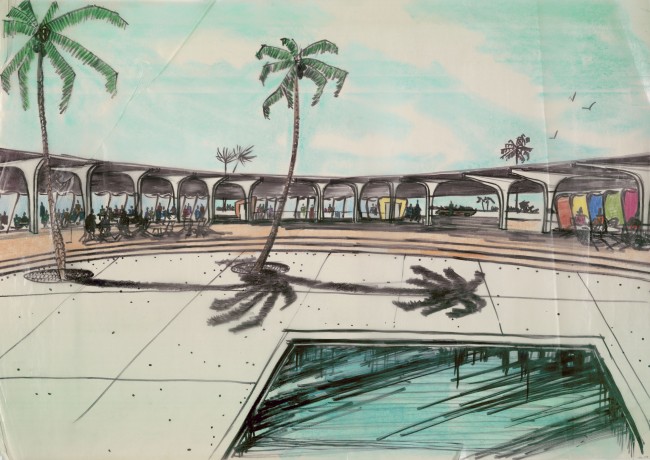
The Bertrand Goldberg: Architecture of Invention exhibition celebrates the work of Chicago architect Bertrand Goldberg. F Newsmagazine architecture critic Maura Lucking sits down with curator Alison Fisher, the Harold and Margot Schiff Assistant Curator of Architecture and Design at The Art Institute of Chicago to talk about Goldberg’s legacy.
Maura Lucking: Where does Goldberg fit into the larger tradition of Chicago architecture?
Alison Fisher: I think that critics, from a very early period, were trying to position Goldberg within the original Chicago School: Sullivan, Burnham, and so forth, in terms of his interest in structural clarity. Obviously he was a faithful student of Mies [van der Rohe], but he really struggled with the orthogonal throughout his career. In that vein, Elizabeth Smith’s catalog essay positions him, alternately, with Mendelssohn, Saarinen and others as really a part of a more international, expressionist tradition.

ML: How important were the multi-disciplinary aspects of his work to the development of his architectural forms?
AF: In this exhibition we are really trying to stress how many aspects of the architectural process Goldberg was involved with. In the 1930s, when his career began, there weren’t as sharp of divisions between design professions. Groups like CIAM really advocated a more holistic approach to architecture. Graphic design and marketing were a major part of his practice, however, which is a bit unusual. He was really successful at promoting his work through visual means, promotional materials, brochures, etc. and took a very novel approach to graphic design using the architectural section as a graphic element, for example.
ML:What or whom do you see as the contemporary legacy of Goldberg’s progressive practice?
AF: In a conceptual sense, Goldberg’s fascination with the architectural object in constant evolution really resonates with a lot of work being done today. He described his North Pole Ice Cream truck, for example, as “a fusion of a vehicle and a building,” something that is certainly echoed in recent projects from Archeworks and others. It’s about mobility, its about considering audience … in large part, it’s about not being pigeonholed into the architectural profession but really being a part of society at large. In terms of direct parallels, Jeanne Gang has named Goldberg as a major influence, saying that she thought a lot about Marina City when designing the Aqua Tower and considered her project a modern update — the high rise as a neighborhood. Farshid Moussavi also engaged with Goldberg’s legacy in The Function of Ornament [published in 2006] in looking at his use of pattern and texture as creating a crucial part of the urban landscape. That use of materiality can really connect architecture to culture.

ML: Any favorite objects in or elements of the exhibition?
AF: We have really just been dazzled by John Ronan’s design for the exhibition, and the way that it brings a new intimacy to looking at Goldberg’s work. Particularly, however, I’m very excited about the new way his design has allowed us to frame Goldberg’s career, where you enter the gallery and step right into Marina City and then sort of parse his career and influences backward, ending with the early residential designs and furniture.//
Bertrand Goldberg: Architecture of Invention
Art Institute of Chicago
Until January 15, 2012
Inside Marina City: A Project by Iker Gil and Andreas E.G. Larsson
Art Institute of Chicago
Until January 15, 2012
Bertrand Goldberg: Reflections
Arts Club of Chicago
Until January 13, 2012
Full disclosure: The writer interned with the Architecture + Design Department during the early organization of the retrospective.






